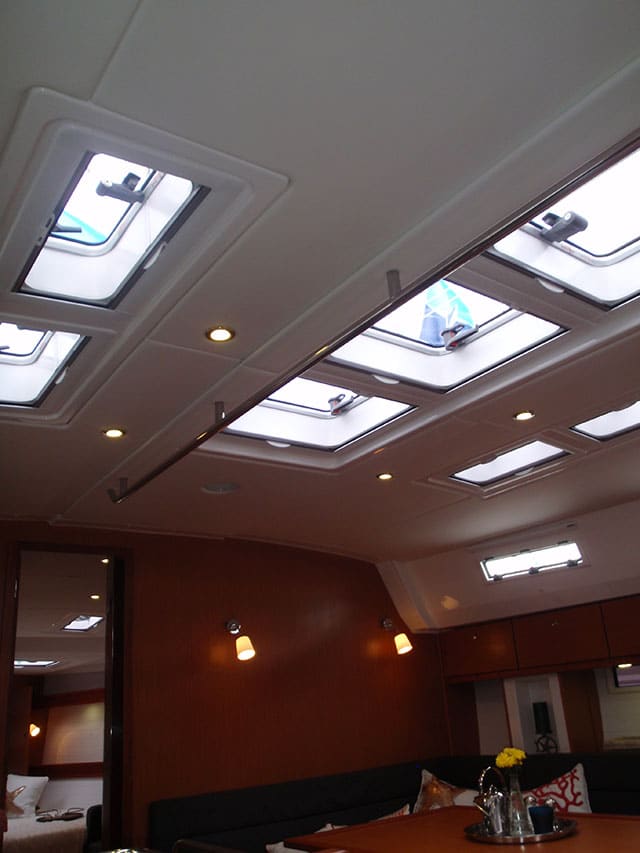
To compensate
High-tech materials, new construction techniques, and shifting priorities have combined to drive such significant changes in modern yacht design as stylized and spacious interiors, twin helms, and gargantuan cockpit/outdoor entertainment areas.
Lost in the shuffle is the middeck real estate on our vessels.
After all, we steer from the back, anchor from the front, and merely pass through the middle, right? Perhaps, but even this taken-for- granted territory merits our attention. Is there proper nonskid? Is the passage forward convenient? Can the sailing tasks that still must be executed at the mast be done so safely?
Let’s start with what might be called the middeck terrain. The traditional squared-off trunk cabin,so configured because of structural requirements inherent to building in wood, has all but disappeared from the modern fleet. Designers sought sleeker lines and less windage. enter the forward-tapering cabin and semi-flush deck. The resulting low cabin sides can no longer accommodate large opening ports, so to counter the loss of interior light and ventilation, a plethora of deck hatches have been added. Hatch sills have progressively shrunk in profile until the absolutely flush hatch with recessed drainage gutters is nearly standard. this, coupled with their size and numbers, make them areas of likely footfall, necessitating uncompromised structural integrity. in other words, there’s no place for “no step” warnings on an active sailing vessel.
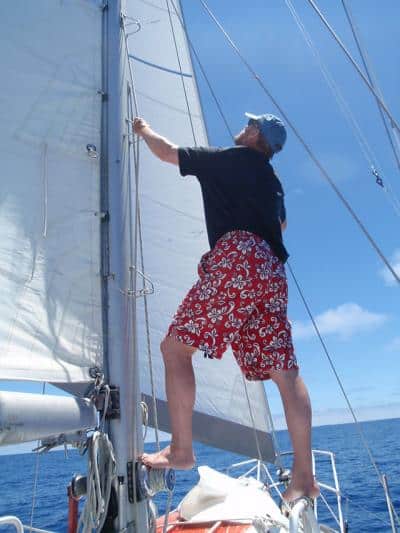
| |Aboard my own steel cutter, Roger Henry, the midships mast pulpit is safe, practical, and serves multiple purposes. Alas, this very handy feature is disappearing from modern cruisers.|
One downside to the low-slung cabin is that handholds are now often positioned just above ankle level, rendering them close to useless for upright sailors. One exception is found on top of the increasingly popular raised-deck-saloon models, which elevates these handholds to a viable level for at least a portion of the journey forward. Anticipating an aging demographic, Gerry Douglas of Catalina Yachts designed a full-length trunk cabin with handholds at the same level as the solid lifelines. In theory, this “walker” approach can extend our careers on the water exponentially.
The old raised-rail handholds have fallen victim to the quest for clean, sharp lines. Handholds are now hidden under long runs of recessed wood or a shallow gutter molded into the cabin top, losing some functionality. Such manufacturers as Passport, Oyster, Moody, and Tartan still believe that dorade vents offer superior ventilation, and these builders usually install them with protective cages. They double as excellent handholds all the way to the foredeck.
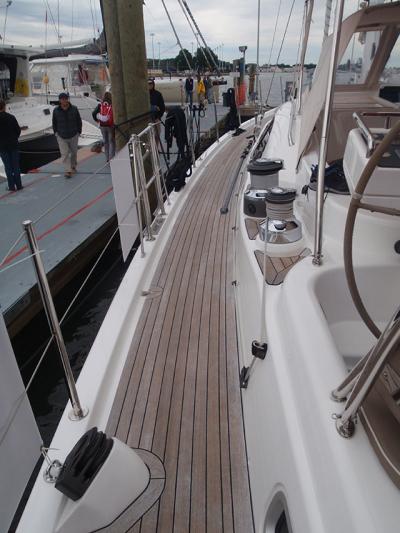
| |Aboard this powerful, well-crafted Oyster 625, the shrouds, sail tracks, lines, and winches have all been positioned inboard, a clever way to keep the side decks free of obstructions.|
The flow forward on a side deck is influenced by a combination of three things: the width of said deck; the placement, inboard or outboard, of the chainplates,and the height of the first spreader, which determines the angle at which the lower aft shroud connects to the deck tang. In extreme cases, this shroud is a “neck stretcher” that requires a nimble pirouette to pass beneath. In the best cases, one can move forward unimpeded, never losing at least a one-handed contact with the ship.
But foot contact is every bit as important for safety, and that relies not only on an effective nonskid but also on its strategic placement. We tend to think of safety in the simplest terms of staying aboard the craft. But even a modest slide into a sharp piece of deck hardware can result in a serious cut, broken toe, or severe sprain. There are no small medical emergencies a thousand miles from land. The aforementioned multiple hatches constitute (and compromise) too much of the square footage of the modern deck to be avoided with certainty, and they therefore must be properly covered with nonskid.
Perhaps to facilitate easy extraction from manufacturing molds, many designs terminate the nonskid short of the cabin edge, leaving alarming expanses of smooth gelcoat. The only slippery slopes I want to ski down are in the Rocky Mountains.
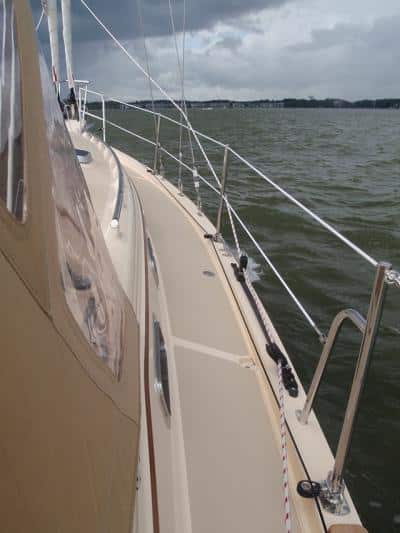
| |Island Packet designer Bob Johnson employs outboard chainplates, full-length trunk cabins with raised handrails, coated lifelines, and substantial raised bulwarks instead of toerails.|
Various nonskid patterns are available, from the traditional slatted teak to molded or raised dimples, diamonds, squiggles, and squares. The more aggressive, the better, but all should be optimized for specifically designed deck shoes or sea boots.
Especially for when a boat’s on a savage heel, a retaining boundary to the deck is a must. While I prefer a pronounced bulwark (which stiffens the stanchions and helps keep sheets and dropped objects from falling overboard), even a single inch of toerail can provide a lifesaving foot grip. Many manufacturers prefer the ease of a perforated, aluminum, bolt-on toerail. If well designed and soundly fastened, snatchblocks can be attached anywhere along the length of a toerail. This is a handy feature, although to most sailors, a varnished wooden rail is more aesthetically pleasing, and several well-placed padeyes can serve the same function.
Both multihulls and monohulls are now designed for aft entry into the cockpit, and several major manufacturers have eliminated amidships gates entirely. But aft entry isn’t always possible in certain sea conditions or when a vessel is tied to the dock, so old-fashioned gates still serve their purpose. Several designers have cleverly incorporated a drop-down gate that doubles as a boarding/swim ladder.
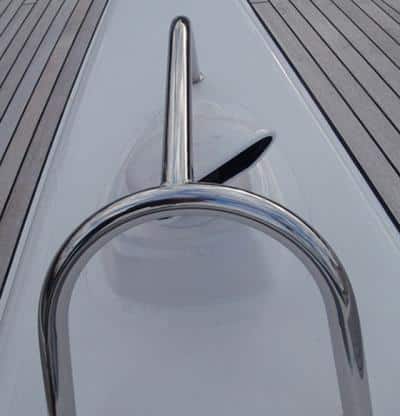
| |Dedicated stainless-steel cages over dorade vents not only protect the fittings from getting stepped on; if they’re strategically placed along or near side decks, they also serve as convenient handholds for sailors moving forward or aft.|
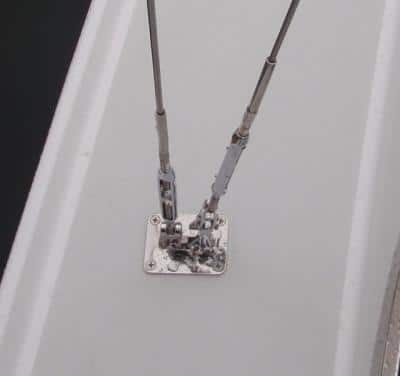
| |Standing rigging can present challenges to designers. On this little sloop, the angle of the lower shroud, combined with the middeck placement of the chainplates, seriously ob-structs safe passages on these very narrow side decks.|
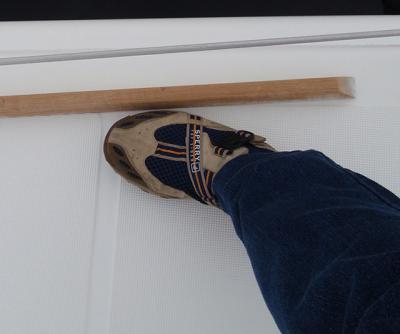
| |Even a single inch of toerail can offer a life-saving foothold. There are three main types: raised bulwarks, wooden (or faux wood) rails, and alumi- num (perforated or solid). Even relatively stable multi- hulls should have solid toerails.|
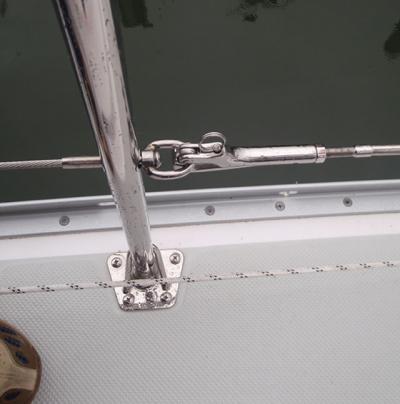
| |There are several issues with this side deck. By placing the stanchions several inches inboard, the width has been narrowed and compromised. And the headsail furling line, adjacent to the boarding gate, can be easily tripped over.|
An amidships cleat seems a trivial detail until you chafe your expensive teak rubrail and dock lines because of foul leads. These cleats can be mounted on the toerails or on the deck inside the toerail and accessed via open or captive chocks or at the deck’s edge in a break in the rubrail. While handy, amidships cleats do tend to foul flagging sheets. recessed or folding cleats are a simple solution, as are after-market cleat covers.
The French first popularized mast pulpits. Because of the growing trend to lead the running rigging aft to the cockpit, sojourns forward to the mast are increasingly unnecessary. Thus, these hip-high retaining bars face extinction. nevertheless, I remain a staunch advocate of mast pulpits. Without restricting the free run of the lanyard safety hook, such mast pulpits keep the jacklines well inboard, a real safety plus. I can stand on the bars of my pulpit to haul down a recalcitrant mainsail, easily access my mast steps, or look ahead in coral-strewn water. I can work from the lee side of the mast on even the harshest of heels because the bars hold me inboard while freeing up both hands. I temporarily attach fenders and spare lines to the bars, and I keep a permanent stowage bag draped beneath them to store foredeck paraphernalia.
While leading all the running rigging aft to the cockpit may be convenient for shorthanded sailing, all the sheets, halyards, outhauls, vang, and reefing lines can give the middeck area the look of a harpsichord. new problems spawn new solutions requiring new nomenclature, like sea hoods. these false decks cover the lines, and by doing so, create open areas for lounging or dinghy stowage. potential downsides include restricted access for cleaning inside the sizable hood and reeving runaway lines again through the narrow leads. special attention must be paid to the entry and outlets of lines for smooth and fair leads to prevent hidden chafe.
As a final small detail, deck caps for diesel, water, and waste are most often positioned in the middeck area. these should be well labeled, perhaps even color coded, and preferably separated in such a way that they’re never accidentally filled with the wrong fluid.
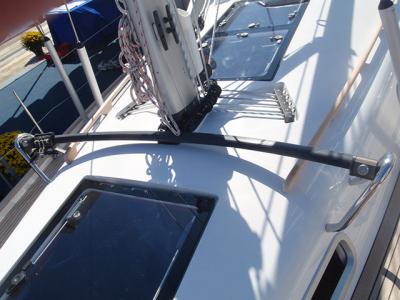
| |Running rigging is often led through false decks called sea hoods. Here, the headsail track obstructs the side deck.|
In summary, remember that every jaunt to the foredeck results in two trips through the amidships area. Whether you’re upgrading your present boat or searching for that shiny new one, factor into your decisions all those elements relating to the safety and function of the middeck area, for it’s figuratively and literally central to good yacht design.
CW contributing editor Alvah Simon is in the midst of a major refit of his 36-foot steel cutter, Roger Henry.
Click here for more in our Design Trends series.








